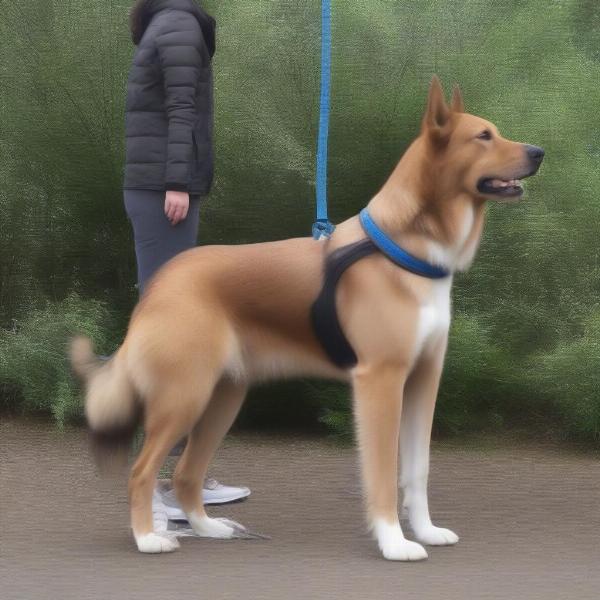A large dog slip lead can be a valuable tool for training and managing your powerful companion, but choosing and using one correctly is crucial. This guide dives into everything you need to know about large dog slip leads, from selecting the right material and size to mastering proper handling techniques. We’ll explore the benefits and drawbacks, address common concerns, and equip you with the knowledge to make informed decisions for your furry friend.
Choosing the Right Slip Lead for Your Large Dog
When selecting a large dog slip lead, consider your dog’s size, breed, and temperament. A lead that’s too thin can be uncomfortable or even dangerous for a powerful dog, while one that’s too thick can be cumbersome. Materials like nylon and rope are durable and easy to clean, while leather offers a classic look and feel. Always opt for a lead with sturdy hardware, such as a welded O-ring, to ensure it can withstand the strength of your dog. slip leads for large dogs come in various lengths; choose one that allows for comfortable control without excessive slack.
Sizing and Material Considerations
For large breeds like Great Danes, Mastiffs, or Rottweilers, a wider and thicker slip lead is essential. Measure your dog’s neck circumference to ensure a proper fit. The lead should be snug but not tight, allowing two fingers to fit comfortably between the lead and your dog’s neck.
Using a Slip Lead Safely and Effectively
 Proper Slip Lead Training Techniques
Proper Slip Lead Training Techniques
A slip lead works by applying gentle pressure when your dog pulls, encouraging them to walk politely. It’s crucial to use the lead correctly to avoid choking or injuring your dog. The lead should sit high on the dog’s neck, just behind the ears. Avoid constant pressure; instead, use short, corrective tugs followed by immediate release.
Training with a Slip Lead
Slip leads can be effective training tools, especially for teaching loose-leash walking and basic obedience. However, they’re not suitable for all dogs. Dogs with respiratory issues or sensitive necks should not wear slip leads. Consult with a professional dog trainer for personalized guidance on proper slip lead usage and training techniques. dog stairs wooden can be a great addition to your home if you have a large dog.
Benefits and Drawbacks of Slip Leads
Slip leads offer the advantage of quick control and can be helpful for training. They are also lightweight and easy to carry. However, improper use can lead to choking or neck injuries. They are also not recommended for everyday walks or for dogs who pull excessively.
“A slip lead, when used correctly, can be a valuable tool for training. However, it’s essential to prioritize your dog’s comfort and safety,” says renowned dog trainer, Sarah Miller, CPDT-KA.
Alternatives to Slip Leads
Consider alternatives like martingale collars or harnesses, especially for dogs prone to pulling or those with sensitive necks. These offer more control and distribute pressure more evenly, reducing the risk of injury. large dog bowl stainless steel are important for large breeds.
Conclusion
Choosing the right large dog slip lead requires careful consideration of your dog’s individual needs. Prioritize safety, proper fit, and correct usage. When used responsibly and in conjunction with positive reinforcement training, a slip lead can be a helpful tool. However, remember that alternatives like martingale collars or harnesses might be more suitable for certain dogs. brown leather collar for dog is a great alternative to slip leads.
FAQ
- Are slip leads safe for large dogs? Slip leads can be safe when used correctly, but improper use can lead to injury.
- What size slip lead do I need for my large dog? Measure your dog’s neck circumference for a proper fit.
- Can I use a slip lead for everyday walks? Slip leads are generally not recommended for everyday walks.
- Are there alternatives to slip leads? Yes, martingale collars and harnesses are safer alternatives.
- How do I train my dog with a slip lead? Consult a professional dog trainer for guidance.
- What material is best for a large dog slip lead? Nylon, rope, and leather are common materials.
- Can a slip lead choke my dog? Yes, improper use can lead to choking.
ILM Dog is a leading international online resource dedicated to providing dog owners with expert advice on all aspects of dog care. From breed selection to health and training, we offer comprehensive and trustworthy information to help you provide the best possible care for your canine companion. Our expertise covers everything from choosing the right dog hair cutting table to providing expert veterinary advice. For any queries, reach out via email at [email protected] or call us at +44 20-3965-8624. ILM Dog is here to support you every step of the way.